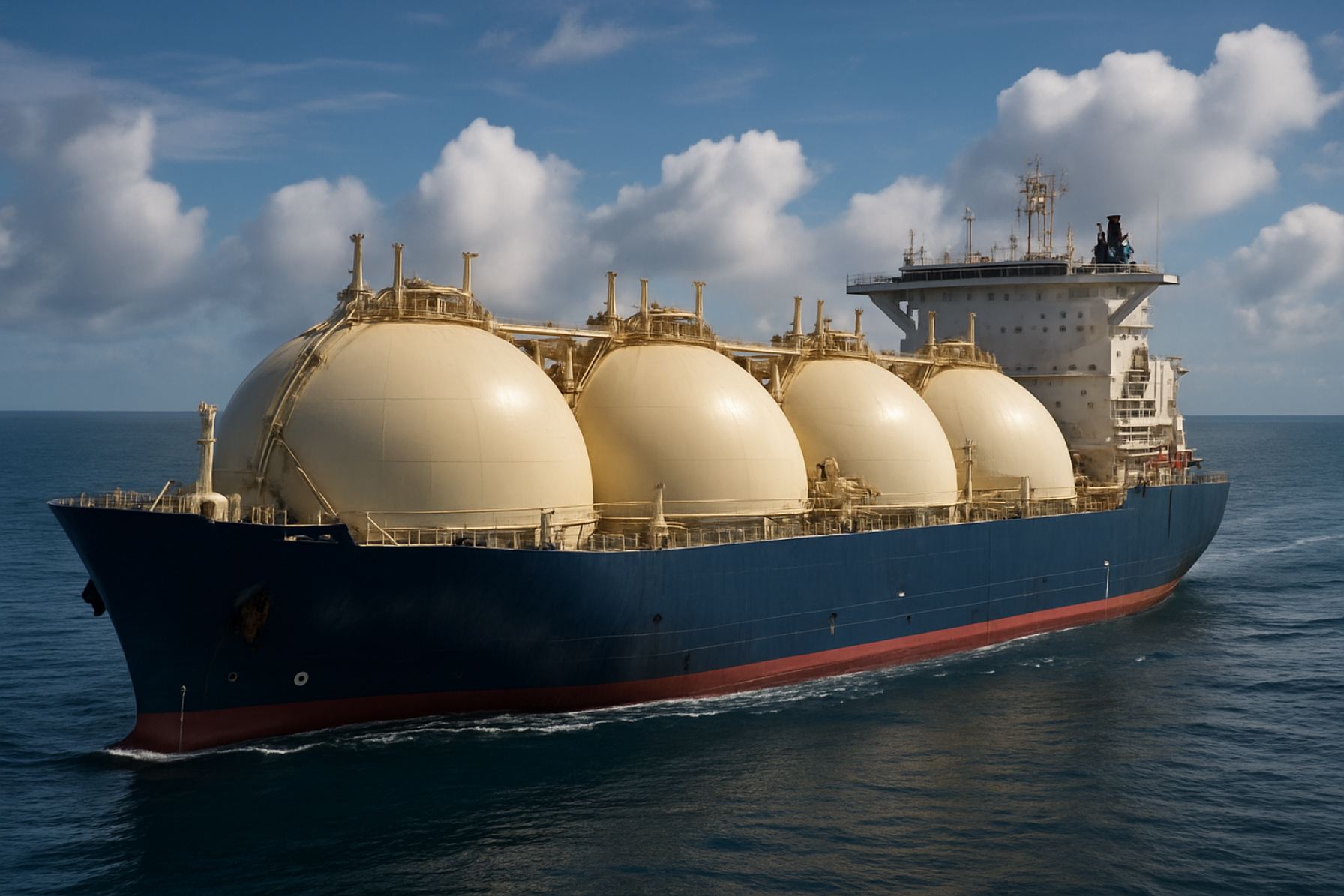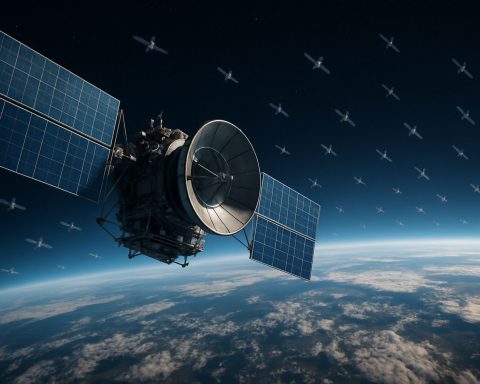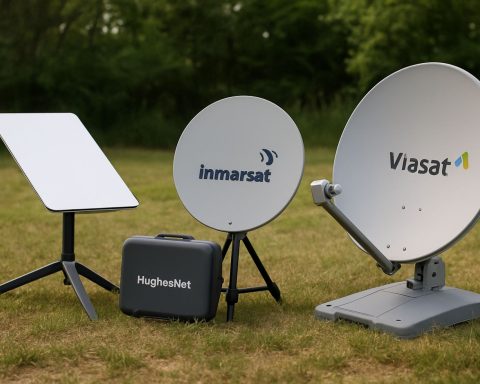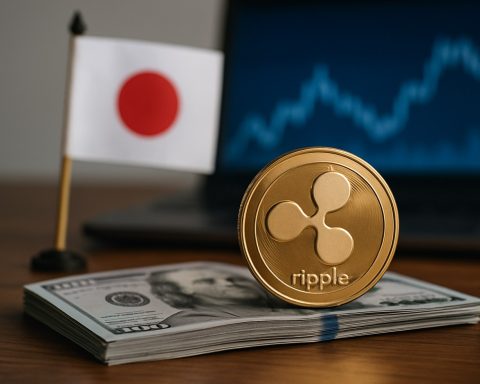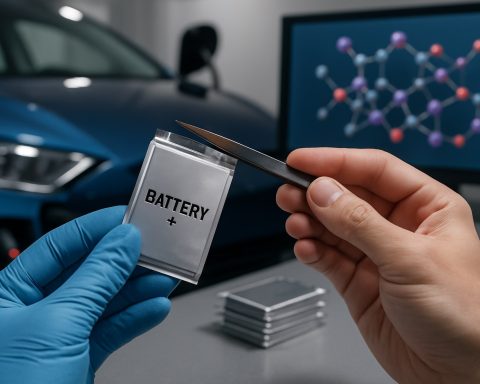LNG Tanker Gasket Engineering 2025–2029: Breakthroughs Set to Disrupt Billion-Dollar Market
Table of Contents
- Executive Summary: Gasket Engineering in LNG Tankers – 2025 and Beyond
- Global LNG Tanker Demand and Impact on Gasket Technologies
- Material Innovations: Next-Gen Gaskets for Cryogenic Resistance
- Key Players and Strategic Partnerships (2025–2029)
- Regulatory Shifts and Compliance: IMO, ASME, and Industry Standards
- Digitalization & Predictive Maintenance: Smart Gasket Monitoring Systems
- Market Forecasts: Growth Projections and Investment Hotspots
- Sustainability Initiatives: Eco-Friendly Gasket Materials and Recycling
- Challenges: Addressing Leakage, Durability, and Operational Risk
- Future Outlook: Emerging Technologies and the LNG Supply Chain Evolution
- Sources & References
Executive Summary: Gasket Engineering in LNG Tankers – 2025 and Beyond
The engineering of gaskets for liquefied natural gas (LNG) tankers is entering a period of accelerated innovation and scrutiny as global LNG demand grows, operational pressures increase, and decarbonization targets reshape the maritime sector. As of 2025, LNG shipping remains pivotal to energy security and transition strategies, with over 700 LNG carriers in operation and a robust orderbook supporting fleet expansion. This growth intensifies the demand for advanced gasket solutions that can ensure safety, integrity, and efficiency under cryogenic conditions, where the temperature routinely falls below -160°C.
Recent years have seen leading tank and containment system providers such as GTT (Gaztransport & Technigaz) driving innovation in membrane technologies and associated sealing systems. Gaskets in LNG tankers must withstand not only extreme thermal cycling and mechanical stress but also aggressive chemical exposure and the risk of micro-leakage, which can compromise cargo quality and safety. GTT’s Mark III and NO96 containment systems, for example, incorporate dedicated insulation and primary/secondary barriers with proprietary gasket solutions that are continually refined to enhance tightness and durability.
Material advancements are also shaping the sector. Major gasket manufacturers such as Flexitallic and Klinger are investing in cryogenic-grade elastomers, PTFE composites, and metallic hybrids to deliver improved resilience and service life. These innovations are increasingly being validated in collaboration with shipyards and LNG operators, aiming to reduce maintenance intervals and mitigate the risk of costly, unplanned downtime.
Regulatory scrutiny is sharpening in the wake of incidents and as classification societies like Lloyd’s Register and the DNV update rules for gas containment and environmental performance. Gasket designs are now subject to more rigorous qualification and testing protocols, emphasizing leak-tightness under both static and dynamic conditions, as well as compatibility with new fuels and operational modes (such as boil-off gas recovery).
Looking ahead, the outlook for gasket engineering in LNG tankers is closely tied to the sector’s broader digitalization and sustainability drives. The next few years will see increased adoption of digital twin technology and condition monitoring, enabling predictive gasket maintenance and real-time performance optimization. At the same time, material recyclability and lifecycle emissions will become key selection criteria as shipowners align procurement with ESG goals. Overall, gasket engineering for LNG tankers in 2025 and beyond is characterized by rapid material innovation, stricter standards, and integration with digital ship management systems to enhance safety, reliability, and environmental compliance.
Global LNG Tanker Demand and Impact on Gasket Technologies
The global demand for liquefied natural gas (LNG) has accelerated sharply in recent years, with forecasts for 2025 and beyond underscoring continued growth as nations transition to cleaner energy sources. According to leading shipbuilders and LNG infrastructure operators, this demand is directly impacting the engineering requirements for critical LNG tanker components, notably gaskets, which play a vital role in maintaining system integrity under extreme operating conditions.
The International Gas Union reports that global LNG trade reached record highs in 2023, with projections indicating a further 5–7% annual volume increase through 2025. This surge is driving a robust orderbook for new LNG carriers, with major shipyards such as Hyundai Heavy Industries and Daewoo Shipbuilding & Marine Engineering investing in advanced materials and process technologies to meet evolving safety and performance standards.
The growing scale and sophistication of LNG tankers necessitate the use of high-performance gasket solutions capable of withstanding cryogenic temperatures, high pressures, and aggressive marine environments. Leading gasket manufacturers, like Flexitallic and Garlock, have reported increased R&D investment in 2024–2025 to develop novel sealing materials, such as PTFE blends and spiral wound gaskets with enhanced low-temperature resilience. These innovations aim to reduce the risk of LNG leakage—a critical safety concern for both environmental and regulatory reasons.
Concurrently, the industry is seeing a move toward digitalization and predictive maintenance. Companies such as Wardley Marine Services are deploying sensor-based monitoring systems on gasketed joints for real-time integrity assessments, helping operators preempt gasket failures and optimize maintenance intervals. This trend is anticipated to gain further momentum through 2025 as tanker operators seek to minimize unplanned downtime and extend vessel lifespans.
Looking ahead, the outlook for gasket engineering in LNG tankers is one of rapid evolution. Regulatory bodies, including the Nippon Kaiji Kyokai (ClassNK) and Lloyd’s Register, are updating standards to reflect the latest advancements in material science and risk management. These standards are expected to elevate gasket performance benchmarks and accelerate the adoption of next-generation sealing technologies across new builds and retrofits. As a result, the interplay between global LNG demand and gasket innovation will remain a defining feature of the sector in 2025 and the years that follow.
Material Innovations: Next-Gen Gaskets for Cryogenic Resistance
Advancements in gasket engineering for LNG tankers are increasingly focused on material innovations that enhance performance under extreme cryogenic conditions. As global demand for LNG rises and shipping capacities expand, the need for reliable, durable gaskets that can maintain tight seals at temperatures as low as -163°C is paramount.
Recent years have seen the introduction of specialized elastomers, composites, and metallic materials tailored for LNG applications. For instance, high-performance PTFE blends and modified thermoplastics are being engineered to resist embrittlement and deformation at cryogenic temperatures. Flexitallic has developed gasket solutions such as the Flexpro™ Kammprofile and the Thermiculite® series, which utilize advanced filler materials for improved chemical and thermal stability in LNG environments. These gaskets are designed to withstand thermal cycling and maintain integrity even during rapid temperature fluctuations experienced during cargo loading and offloading.
Metallic and semi-metallic gaskets are also evolving to meet LNG tanker requirements. Klinger Limited offers cryogenic gaskets manufactured with corrugated stainless steel cores and graphite or PTFE facing, providing a combination of resilience and low-temperature sealing properties. Innovations in spiral wound designs allow for reduced leakage rates and enhanced adaptability to flange movements caused by thermal contraction.
Material selection is also being guided by emerging regulations and safety standards imposed by international bodies. For example, the International Maritime Organization (IMO) and classification societies increasingly require certified performance of sealing materials under simulated LNG service conditions. Suppliers such as Garlock are responding with rigorous cryogenic testing protocols, ensuring their LNG-specific gaskets meet or exceed industry benchmarks for leakage, chemical compatibility, and mechanical strength.
Looking ahead to 2025 and beyond, the outlook for next-generation LNG tanker gaskets includes further adoption of nanocomposite materials and hybrid structures that combine the flexibility of polymers with the strength of metallic reinforcements. Companies are also investing in digital monitoring solutions, embedding sensors in gasket assemblies to provide real-time data on seal performance and predict maintenance needs. This trend aligns with the broader digitalization of LNG shipping, aiming to reduce unplanned downtime and enhance operational safety.
In summary, material innovations for gaskets in LNG tankers are converging on improved cryogenic resistance, longer service life, and compliance with stricter safety standards. These advancements are critical as the LNG shipping sector prepares for higher volumes and increasingly demanding operational environments in the coming years.
Key Players and Strategic Partnerships (2025–2029)
The period from 2025 through 2029 is poised to witness significant developments in gasket engineering for LNG (liquefied natural gas) tankers, driven by key players expanding their technological capabilities and forming strategic alliances to address stringent safety, durability, and environmental requirements. The global increase in LNG demand—projected to remain robust through the decade—continues to propel investment in cryogenic containment technologies, including advanced gasket solutions that ensure leak-tight integrity and thermal performance under extreme conditions.
Among the leading organizations, The Flexitallic Group maintains a prominent role by supplying specialized spiral wound and kammprofile gaskets designed for cryogenic LNG applications. In 2025, Flexitallic has announced collaborative R&D initiatives with major LNG shipyards in South Korea and Japan, focusing on next-generation sealing materials resilient to thermal cycling and chemical attack. Similarly, Garlock Sealing Technologies continues to innovate with their expanded PTFE (ePTFE) and graphite-based gasket solutions, recently partnering with global LNG containment system provider GTT (Gaztransport & Technigaz). This partnership aims to optimize gasket integration into Mark III and NO96 membrane containment systems, which are widely adopted in newbuild LNG carriers.
Additionally, Klinger Holding has reinforced its supply agreements with multiple European and Asian shipyards, securing its position as a preferred supplier for LNG tanker projects. Klinger’s recent focus is on the development of high-resilience sealing pads and flange gaskets tailored for rapid installation and maintenance cycles, addressing the growing need for operational efficiency and reduced vessel downtime. In parallel, Trelleborg Marine & Infrastructure has intensified collaborations with shipbuilders to deliver bespoke LNG transfer and bunker hose gaskets, emphasizing long-term cryogenic performance and compliance with evolving IMO and IGC Code standards.
- The Flexitallic Group: Pioneering advanced spiral wound and kammprofile gaskets for LNG containment.
- Garlock Sealing Technologies: Strategic partnership with GTT for membrane system gaskets.
- Klinger Holding: Expanded supply agreements for rapid-installation sealing solutions.
- Trelleborg Marine & Infrastructure: Custom gaskets for LNG transfer and bunkering applications.
Going forward, the competitive landscape is expected to be shaped by material science advancements, digitalized gasket monitoring solutions, and a trend toward integrated supply chains between gasket manufacturers, shipyards, and containment system providers. These strategic collaborations are anticipated to accelerate the deployment of innovative sealing technologies, supporting the safe and efficient growth of the LNG shipping industry through 2029.
Regulatory Shifts and Compliance: IMO, ASME, and Industry Standards
The rapidly evolving regulatory landscape for LNG tankers is reshaping the engineering and selection of gaskets, with a direct impact from organizations like the International Maritime Organization (IMO), the American Society of Mechanical Engineers (ASME), and other industry standards bodies. As of 2025, the IMO’s ongoing commitment to environmental stewardship—evident in regulations such as the International Code for the Construction and Equipment of Ships Carrying Liquefied Gases in Bulk (IGC Code)—demands ever-tighter controls on fugitive emissions and leak prevention. Gasket materials and designs must now demonstrate compatibility with cryogenic environments and resistance to permeation, as stipulated under the IGC Code and related MARPOL requirements (International Maritime Organization).
ASME’s Boiler and Pressure Vessel Code (BPVC), particularly Sections VIII and IX, remains a cornerstone for the mechanical integrity of LNG containment systems, dictating rigorous test protocols and material certifications for gaskets and sealing assemblies. In 2025, ASME is continuing to update its standards to reflect advances in sealing technology, including the qualification of new elastomeric and composite materials suitable for LNG service (American Society of Mechanical Engineers). Gasket manufacturers are consequently investing in R&D to meet both mechanical and chemical compatibility benchmarks, as required for cryogenic applications.
Industry actors such as Flexitallic and Garlock are closely aligning their product offerings with both IMO and ASME mandates, developing low-emission, high-integrity sealing solutions specifically engineered for LNG tanker operations. For example, spiral wound and kammprofile gaskets incorporating advanced graphite and PTFE blends are being validated for performance in accordance with both international and customer-driven standards.
Looking ahead, the harmonization of global standards is expected to intensify. In 2025 and the coming years, the IMO is set to further tighten GHG emission controls and operational safety standards, which will likely prompt additional revisions to gasket qualification and inspection criteria. OEMs and operators are expected to demand more transparent traceability and lifecycle documentation for gaskets, while material suppliers will need to demonstrate compliance via third-party certification and digital recordkeeping. The interplay between regulatory evolution, material science, and operational best practices will thus continue to define the state of gasket engineering for LNG tankers through the remainder of the decade.
Digitalization & Predictive Maintenance: Smart Gasket Monitoring Systems
Digitalization and predictive maintenance are rapidly transforming gasket engineering for LNG tankers, with smart gasket monitoring systems at the forefront of this evolution in 2025 and the years ahead. The LNG shipping sector faces stringent safety and reliability requirements due to the hazardous nature of cryogenic liquefied natural gas, making the integrity of critical sealing components such as gaskets a top priority. In recent years, digitalization has enabled real-time monitoring and predictive diagnostics, fundamentally changing maintenance strategies.
Smart gasket monitoring systems deploy sensors to continuously collect data on variables like temperature, pressure, vibration, and gasket compression. These sensor arrays feed information into shipboard or cloud-based analytics platforms, where machine learning algorithms detect deviations or early signs of wear, enabling predictive maintenance. This approach significantly reduces the risk of catastrophic leaks and unplanned downtime, both of which can have severe safety and financial implications for LNG carriers.
Industry leaders are already advancing these technologies. Flexitallic has introduced gasket solutions with embedded RFID and sensor capabilities for asset tracking and condition monitoring, supporting digital maintenance regimes. Meanwhile, sealing specialists such as Freudenberg Sealing Technologies have invested in “smart sealing” R&D, focusing on the development of gaskets that can communicate their operational state and remaining life expectancy, tailored for demanding cryogenic and LNG environments.
Class societies and industry groups recognize the potential of digitalization for LNG tanker safety. The Lloyd’s Register digital compliance frameworks now include guidance for the integration and validation of smart sensor systems in marine applications, encouraging wider adoption of predictive maintenance tools for critical components like gaskets. Similarly, DNV has published digital assurance protocols and collaborated with technology providers to trial real-time monitoring on LNG vessels, aiming to standardize best practices by 2026.
Looking ahead, the outlook for smart gasket monitoring in LNG tankers is robust. The rapid expansion of global LNG trade, larger and more complex vessel designs, and regulatory focus on operational safety will continue to drive the adoption of digital maintenance solutions. Shipowners and operators are expected to prioritize vessels equipped with integrated gasket monitoring for newbuilds and retrofits, leveraging the resulting data for risk-based maintenance planning, extended gasket lifecycles, and compliance with evolving safety standards.
Market Forecasts: Growth Projections and Investment Hotspots
The market for gasket engineering in the LNG tanker sector is entering a dynamic phase as global LNG demand expands and fleet modernization accelerates through 2025 and beyond. The International Maritime Organization’s tightening regulations on methane emissions and cargo containment efficiency are pushing shipbuilders and operators to adopt advanced gasket solutions that ensure both safety and environmental compliance. According to GTT (Gaztransport & Technigaz), a leading designer of LNG containment systems, the orderbook for LNG carriers remains robust, underpinned by both newbuild contracts and retrofitting projects that require state-of-the-art sealing technologies.
From 2025 onward, the Asia-Pacific region is set to be a significant investment hotspot, led by South Korean and Chinese shipyards such as Hyundai Heavy Industries and China State Shipbuilding Corporation. These shipbuilders are incorporating advanced gasket materials and designs to support the construction of new LNG carriers with enhanced boil-off gas rates and longer service lives. In parallel, European engineering firms, particularly those in Norway, are focusing on innovations in cryogenic gasket technology for Arctic LNG transport, responding to the growing demand for ice-class vessels in the Northern Sea Route.
Major gasket manufacturers—including Flexitallic Group and Garlock—are investing in R&D to deliver solutions that can withstand the extreme thermal cycling and chemical exposure characteristic of LNG shipping. For example, Flexitallic has recently expanded its production capacity in France and the UK to meet increasing demand for spiral wound and kammprofile gaskets for LNG containment, emphasizing low-leakage and long-term durability.
Growth projections indicate that the LNG tanker gasket market will see mid-to-high single digit annual expansion over the next several years, driven not only by the delivery of new vessels but also by the need for aftermarket maintenance and upgrades on the existing global fleet. Investment is also flowing into digital monitoring technologies that enable predictive maintenance of gaskets, reducing unplanned downtime and enhancing vessel safety—a trend supported by technology providers like Wärtsilä.
Looking ahead, the intersection of regulatory pressure, decarbonization goals, and LNG trade expansion will continue to direct capital toward advanced gasket engineering in LNG shipping, with the strongest growth expected in Asia, the Middle East, and select European markets over the next few years.
Sustainability Initiatives: Eco-Friendly Gasket Materials and Recycling
Sustainability continues to redefine engineering priorities in the LNG tanker sector, with a significant focus on eco-friendly gasket materials and recycling initiatives in 2025 and beyond. As regulatory agencies tighten emissions standards and shipping companies commit to decarbonization, gasket manufacturers are responding with innovative solutions to reduce environmental impact throughout the gasket lifecycle.
A key trend is the shift towards non-asbestos, halogen-free, and low-VOC (volatile organic compound) gasket materials. For example, Flexitallic has advanced its product line with gaskets made from high-integrity graphite and bio-based fillers, designed to perform reliably in cryogenic LNG environments while minimizing hazardous substance content. Similarly, Klinger has expanded its portfolio of PTFE and fiber-reinforced gaskets with improved chemical resistance and reduced environmental footprint.
In 2025, LNG tanker operators are increasingly specifying gaskets that meet or exceed international standards for environmental safety, such as those set out by the International Maritime Organization. Manufacturers like Garlock are actively developing products certified for low-emission applications and are providing environmental product declarations (EPDs) to support transparent lifecycle assessments.
Recycling and circularity initiatives are also gaining momentum. Gasket suppliers are collaborating with shipbuilders and operators to establish take-back schemes for used gaskets. Trelleborg Marine & Infrastructure has piloted a program to recycle elastomeric and composite gaskets removed during LNG tanker maintenance, processing these materials into secondary products for non-critical applications. This approach not only diverts waste from landfills but also reduces the demand for virgin raw materials.
Despite these advances, challenges remain in scaling up recycling for composite gasket materials, particularly those with metallic or multi-layer construction. Nevertheless, ongoing R&D by manufacturers aims to improve material separability and recyclability—an area likely to see further breakthroughs as pressure mounts for sustainable shipping solutions.
Looking ahead, the outlook for eco-friendly gasket materials and recycling in LNG tanker engineering is positive. As regulatory and commercial drivers intensify, manufacturers are expected to integrate even more renewable content, develop closed-loop recycling processes, and extend the use of digital platforms for tracking gasket lifespan and facilitating recovery. By 2030, it is anticipated that sustainable gasket solutions will become standard practice across much of the LNG tanker fleet, contributing to broader maritime decarbonization goals.
Challenges: Addressing Leakage, Durability, and Operational Risk
The demands of liquefied natural gas (LNG) tanker operations place extraordinary requirements on gasket engineering, with leakage prevention, durability, and operational risk mitigation emerging as persistent challenges in 2025 and the near future. As LNG cargoes are transported at cryogenic temperatures (typically -162°C), gaskets must deliver robust sealing performance while enduring repeated thermal cycling, mechanical stresses, and chemical exposures unique to marine environments.
Leakage remains a critical focus, given the safety, environmental, and commercial risks associated with even minor LNG escapes. Recent advances in gasket design for membrane containment systems, such as those developed by GTT (Gaztransport & Technigaz), emphasize multi-layer composite structures and precision-manufactured metallic and elastomeric components. These innovations aim to reduce the probability of leaks at tank penetrations, piping flanges, and insulation barriers.
Durability is challenged by the extremes of temperature cycling during loading and unloading, as well as by mechanical vibration and dynamic loads during voyages. Material selection and compatibility are critical: leading manufacturers such as Flexitallic and Klinger are investing in advanced PTFE, modified graphite, and metal-reinforced gaskets engineered specifically for cryogenic applications. These gaskets are tested for resistance to cryogenic embrittlement, thermal contraction, and chemical degradation from LNG and its boil-off gases. Notably, the industry is moving towards gaskets with longer service life and reduced maintenance intervals, an imperative as global LNG shipping volumes continue to rise (Shell).
Operational risk is further compounded by the complexity of LNG tanker systems. Gasket failure can result in loss of containment, rapid LNG vaporization, and potential fire or explosion hazards. To address this, companies such as Trelleborg have introduced gaskets with embedded leak detection features and integrated performance monitoring. Additionally, digitalization and predictive maintenance initiatives—supported by sensor-equipped gaskets and real-time analytics—are being piloted by vessel operators and OEMs to catch early warning signs of degradation (GTT).
Outlook for the next few years indicates further tightening of regulatory standards and increased scrutiny on gasket reliability as fleet sizes and voyage frequency grow. The engineering community is expected to prioritize materials R&D, enhanced testing protocols, and standardization of digital monitoring to proactively address leakage, durability, and operational risk on LNG tankers worldwide.
Future Outlook: Emerging Technologies and the LNG Supply Chain Evolution
As the LNG market continues its dynamic expansion into 2025 and beyond, gasket engineering for LNG tankers is entering a period of rapid innovation, driven by tightening environmental standards, increasing cargo volumes, and advances in cryogenic containment technologies. Gasket systems, essential for maintaining the integrity of LNG containment and transfer systems, are evolving to meet the demands of new vessel designs, operational safety, and efficiency imperatives.
A significant trend shaping the future of gasket engineering is the adoption of next-generation materials engineered to withstand the extreme cryogenic temperatures encountered in LNG transport, often below -160°C. Leading manufacturers such as Flexitallic Group are focusing on advanced composites and elastomers that offer both chemical resistance and long-term dimensional stability, minimizing the risk of leaks and emissions. In 2025, the industry is seeing early adoption of low-emission gaskets, including spiral wound and Kammprofile designs with enhanced sealing performance, in response to stricter methane emission controls and the drive for zero-leakage operations.
Digitalization and sensor integration are also emerging as transformative technologies for gasket monitoring. Companies like KLINGER Group are investing in gasket solutions that embed sensing elements, enabling real-time monitoring of sealing integrity during cargo operations and transit. This approach aligns with the broader LNG sector’s shift towards predictive maintenance and digital twins, supporting proactive intervention and reducing the risk of costly unplanned outages.
The evolution of LNG containment systems, such as the Mark III and NO96 membrane technologies supplied by GTT (Gaztransport & Technigaz), is driving the need for specialized gasket designs compatible with these increasingly complex architectures. Gasket suppliers are collaborating more closely with containment system providers to develop customized, high-reliability sealing solutions that can cope with thermal cycling and vessel flexing over extended service lives.
Looking ahead, the LNG supply chain’s anticipated growth—driven by new liquefaction projects and a global pivot towards cleaner fuels—will likely accelerate the adoption of these emerging gasket technologies. Regulatory pressures from the International Maritime Organization (IMO) and national authorities are expected to further spur innovation, particularly in the area of fugitive emission reduction. The coming years will also see increased standardization and qualification of new gasket materials and designs, as exemplified by ongoing R&D collaborations between shipyards, operators, and gasket manufacturers. By 2030, fully integrated, smart gasket systems may become standard equipment on newbuild LNG tankers, supporting both operational excellence and environmental stewardship.

